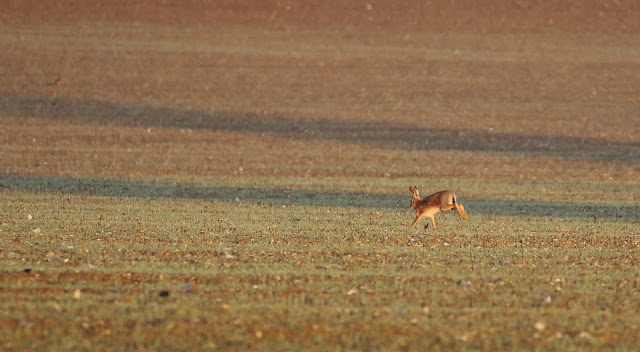From his 'lockdown bedroom office', Andy M has recently been able to watch more of the birds in his garden, in particular the comings and goings of the corvids - Magpie and Jay - and Sparrowhawks, which don't stay long, but are a spectacle to watch - as were the Blackbird feasting on the garden hawthorn berries.
Sightings and news for the Naturewatch group of Great and Little Abington in Cambridgeshire, UK. See below for more details and information on how to join.
Sunday, 29 November 2020
More Garden Birds
Monday, 23 November 2020
Muntjac
An apparently quite young Muntjac deer made a (slightly unwelcome) visit to Derek T's garden today, and paused long enough in the sun to offer up a photo-opportunity!
Recording of Tawny Owl calling in Lt Abington
There have been a number of recent reports of a Tawny Owl calling from the woods behind Church Lane, but Kumar has gone further, and managed to very quietly get close enough to make this lovely recording.
Click on this link to hear it: Abington resident Tawny Owl
Male and female Tawny Owl both call during the night, particularly in the autumn and early winter, to establish territories, and to make contact and attract a mate.
The hooting territorial call of the male (as in Kumar's recording) being most familiar, starts with a drawn-out 'hoooouh', pauses for a few seconds, then ends with a resonant ..... hoo-hoo-hooooouh'.
Both sexes also make a more harsh 'kewick' contact call, and during courtship, the male and female may respond to one-another, combining their calls to make the commonly quoted 'too-wit too-woo' which is a combination of the 'kewick' (female) and 'hoo-hoo-hooooouh' (male) calls.
Dazed Goldcrest
Elly M, from Granta Park, contacted Derek to report that a Goldcrest had recently flown into the window of the security gatehouse. The Goldcrest was a little dazed by the experience, and the security guard was able to take a couple of photos, before the bird recovered and flew off without further incident.
Apparent scarcity of garden birds
David F has been concerned recently that, despite putting out bird food in his garden, there seemed to be a scarcity of garden birds visiting his garden this autumn. Having contacted the BTO about this, he received the following reply from the 'garden.ecology@BTO.org' team:
'Thank you very much for getting in touch with us. Yes, we have received a lot of similar reports recently. It seems that the lack of garden birds has been caused by the availability of natural food away from gardens, mainly due to the predominantly mild and wet weather. We haven't noticed anything else that has changed significantly so hopefully, now that the temperature is starting to drop, you will start to see more birds in your garden. I hope this helps and if you have any further questions or queries, please do not hesitate to get in touch with us.'
Sunday, 15 November 2020
Early Morning Walk to Hildersham Wood
The promise of a clear sunny start enticed Andy M out for an early morning walk along Chalky Road to Hildersham Wood this week. The rising sun highlighted the last of the autumn colours, and really made the brightly-coloured berries in the hedgerows shine out.
As expected, there were lots of Rosehip and Hawthorn berries, as well as Sloes, but also a good crop of gaudy pink Spindle berries in several places. Along the Old Railway Cutting, Redwing and Blackbird were busy tucking into a berry breakfast, and a female Sparrowhawk was ever-watchful for a passing birds.
Saturday, 14 November 2020
Early morning along the Roman Road
Early one morning this week, Andy M walked along the eastern end of the Roman Road in Abington, near the Hildersham boundary, just as the sun was rising. The low sunlight was beautiful, illuminating the animals and birds as they started their day. Besides the more usual creatures - Hare, Linnet, Partridge, Corn Bunting, Skylark, Yellowhammer - Andy also saw a pair of Stonechat. Breeding further north on moorland during the summer, Stonechat migrate south to spend the winter in the southern areas of Britain.
The Aims of Abington Naturewatch
At their meeting on 9 April 2005 the members approved this revised version of the aims of Abington Naturewatch:
- To monitor and record the wildlife (fauna & flora) within the borders of the Abingtons;
- To encourage protection of our wildlife, maintain its quality and foster its diversity;
- To promote awareness of the richness, potential and problems of the natural environment of the Abingtons;
- To cooperate in improving access to the local natural environment for the benefit of all Abington villagers.
The organisation is informal and communication is by email if possible; members are notified of events from time to time. Contact details are maintained by a small "project team". There is currently no membership fee as costs are covered by voluntary contributions at events.
Members are encouraged to report notable sightings of flora and fauna within the Abingtons to the appropriate sector coordinator and an illustrated record is published annually.
A map of the area covered, with some features noted, is available here: http://maps.google.co.uk/maps/ms?ie=UTF8&hl=en&msa=0&msid=213774935674882866424.00000111dca2be9f06ab8&z=13>
For more information or to join, please contact David Farrant on (01223) 892871.
Contributions to our records should be sent to sector contacts or either of the above. Photographs may also be submitted to Andy Merryweather (amerryweather61@gmail.com)



















































